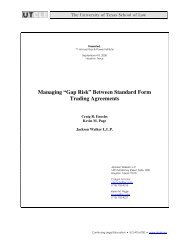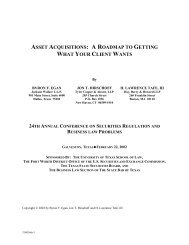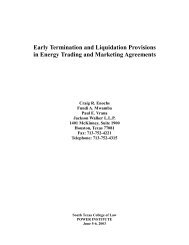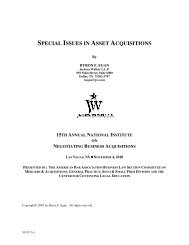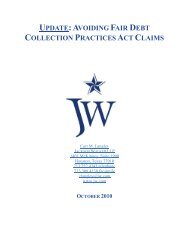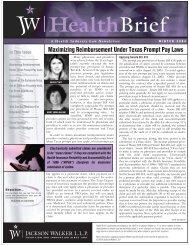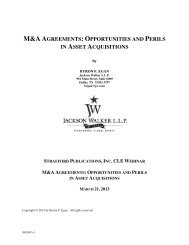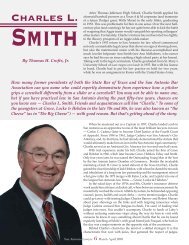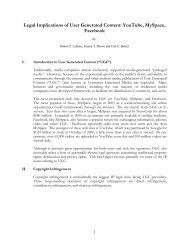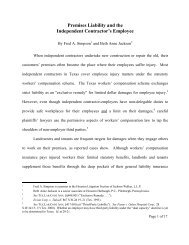fiduciary duty issues in m&a transactions - Jackson Walker LLP
fiduciary duty issues in m&a transactions - Jackson Walker LLP
fiduciary duty issues in m&a transactions - Jackson Walker LLP
You also want an ePaper? Increase the reach of your titles
YUMPU automatically turns print PDFs into web optimized ePapers that Google loves.
While Caremark recognizes a cause of action for un<strong>in</strong>formed <strong>in</strong>action, the hold<strong>in</strong>g is subject tothe follow<strong>in</strong>g:First, the Court held that “only a susta<strong>in</strong>ed or systematic failure of the board to exerciseoversight — such as an utter failure to attempt to assure a reasonable <strong>in</strong>formation and report<strong>in</strong>gsystem exists — will establish the lack of good faith that is a necessary condition to liability.” 72It is thus not at all clear that a pla<strong>in</strong>tiff could recover based on a s<strong>in</strong>gle example of director<strong>in</strong>action, or even a series of examples relat<strong>in</strong>g to a s<strong>in</strong>gle subject.Second, Caremark noted that “the level of detail that is appropriate for such an<strong>in</strong>formation system is a question of bus<strong>in</strong>ess judgment,” 73 which <strong>in</strong>dicates that the presence of anexist<strong>in</strong>g <strong>in</strong>formation and report<strong>in</strong>g system will do much to cut off any derivative claim, becausethe adequacy of the system itself will be protected.Third, Caremark considered it obvious that “no rationally designed <strong>in</strong>formation system. . . will remove the possibility” that losses could occur. 74 As a result, “[a]ny action seek<strong>in</strong>grecovery for losses would logically entail a judicial determ<strong>in</strong>ation of proximate cause.” 75 Thishold<strong>in</strong>g <strong>in</strong>dicates that a loss to the corporation is not itself evidence of an <strong>in</strong>adequate <strong>in</strong>formationand report<strong>in</strong>g system. Instead, the court will focus on the adequacy of the system overall andwhether a causal l<strong>in</strong>k exists. 76The Caremark issue of a board’s systematic failure to exercise oversight was revisited bythe Seventh Circuit apply<strong>in</strong>g Ill<strong>in</strong>ois law <strong>in</strong> In re Abbott Laboratories Derivative ShareholdersLitigation. 77 Abbott <strong>in</strong>volved a shareholders derivative suit aga<strong>in</strong>st the health care corporation’sdirectors, alleg<strong>in</strong>g breach of <strong>fiduciary</strong> <strong>duty</strong> and assert<strong>in</strong>g that the directors were liable under statelaw for harms result<strong>in</strong>g from a consent decree between the corporation and the Food and DrugAdm<strong>in</strong>istration (“FDA”). The consent decree had followed a six-year period dur<strong>in</strong>g which theFDA had given numerous notices to the corporation of violations of FDA manufactur<strong>in</strong>gregulations and imposed a $100 million f<strong>in</strong>e, which resulted <strong>in</strong> a $168 million charge to earn<strong>in</strong>gs.In revers<strong>in</strong>g a district court dismissal of pla<strong>in</strong>tiff’s compla<strong>in</strong>t for failure to adequately plead thatdemand upon the board of directors would be futile, the Seventh Circuit held that the compla<strong>in</strong>tsraised reasonable doubt as to whether the directors’ actions were the product of a valid exerciseof bus<strong>in</strong>ess judgment, thus excus<strong>in</strong>g demand, and were sufficient to overcome the directors’727374757677Id. at 971.Id. at 970.Id.Id. at 970 n.27.See generally Eisenberg, Corporate Governance The Board of Directors and Internal Control, 19 CARDOZO L. REV.237 (1997); Pitt, et al., Talk<strong>in</strong>g the Talk and Walk<strong>in</strong>g the Walk: Director Duties to Uncover and Respond toManagement Misconduct, 1005 PLI/CORP. 301, 304 (1997); Gruner, Director and Officer Liability for DefectiveCompliance Systems: Caremark and Beyond, 995 PLI/CORP. 57, 64-70 (1997); Funk, Recent Developments <strong>in</strong>Delaware Corporate Law: In re Caremark International Inc. Derivative Litigation: Director Behavior, ShareholderProtection, and Corporate Legal Compliance, 22 DEL. J. CORP. L. 311 (1997).325 F.3d 795 (7th Cir. 2003). The Abbott court dist<strong>in</strong>guished Caremark on the grounds that <strong>in</strong> the latter, there was noevidence <strong>in</strong>dicat<strong>in</strong>g that the directors “conscientiously permitted a known violation of law by the corporation to occur,”unlike evidence to the contrary <strong>in</strong> Abbott. Id. at 806 (quot<strong>in</strong>g Caremark, 698 A.2d at 972). However, the Abbott courtnonetheless relied on Caremark language regard<strong>in</strong>g the connection between a board’s systemic failure of oversight anda lack of good faith. Abbott, 325 F.3d at 808-09.5446095v.116



